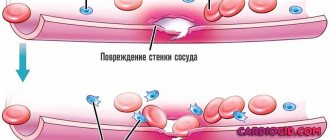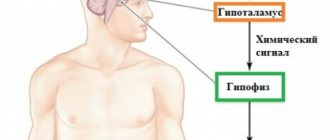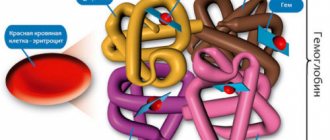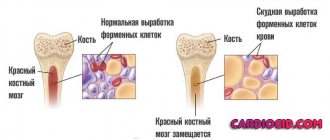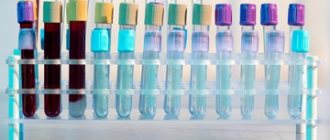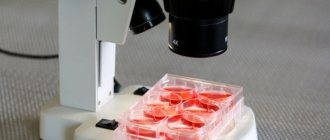Ferritin is a protein component that is responsible for storing non-toxic ferric iron throughout the body. At the same time, it performs several important functions, in particular:
- Delivers oxygen to tissues;
- Provides material for the creation of hemoglobin;
- Delivers oxygen to the intestines;
- Transfers iron from mother to child through the placental layer.
The above indicates that ferritin is a very important component in our body. However, very often its level can differ greatly from the norm, both down and up. If this happens, then this gives reason to believe that some kind of pathology is developing in the body. Today we’ll talk about what are the reasons for increased ferritin in the blood and what drugs should be used to increase ferritin in order to normalize its level.
Why does ferritin increase?
This can be observed due to the development of the disease hemochromatosis - in simple terms, this is a violation of iron storage.
The causes of the disease are primarily hereditary. There is an accumulation of iron in the body more than it should be. First of all, an excess is observed in the liver, heart, and in men, in the testicles. It should be noted that men’s bodies tend to accumulate it much faster than women’s. Their portion is wasted during natural processes, namely menstruation.
High ferritin in the analysis can be indicated in the development of an inflammatory process - osteomyelitis, burns, infectious processes, oncological diseases. An increase in ferritin can lead to cardiosclerosis; at this time, the heart muscle becomes very dense, grows, and turns brown in color. Frequent blood transfusions can also increase the level of the substance.
Causes of iron protein deficiency with normal hemoglobin
The causes of low ferritin levels are numerous provoking factors, which are important to eliminate in a timely manner in order to prevent the occurrence of serious complications:
| Gender, age | Causes of low ferritin |
| Among women |
|
| In men | |
| In pregnant women |
|
| In children |
|
It is important to diagnose the causes of low ferritin with normal hemoglobin in a timely manner. It is necessary to start treatment at the early stages of emerging disorders and prevent dangerous consequences. These are hypoxia, a decrease in the body's defenses, heart disease, damage to the kidneys and genital organs.
The importance of ferritin for the body
Iron plays an important role in the human body. In tissues, it is stored in the form of the protein ferritin, which is involved in the metabolism of iron ions, converting it from a toxic trivalent into a harmless substance. Ferritin in the blood is needed for the normal synthesis and functioning of hemoglobin and phosphate metabolism. Heme molecules contain iron, which ensures the transport of oxygen into red blood cells, anabolic and catabolic processes. Iron is an important component of the muscle protein myoglobin and is part of enzymes.
The vast majority of the substance is contained in red blood cells. Other strategic reserves are tissue of the liver, bone marrow, and spleen. The protein is needed to deposit and act as a mitochondrial acceptor of iron hydroxide inside erythroblasts. Iron protein is responsible for the transport of the substance to the intestines and placenta, acting as a mediator for the addition of metal ions to transferrin and transport from mother to child.
What is the normal level of ferritin in a blood test?
Iron is an important element that the human body needs for normal functioning. The protein complex ferritin is the main indicator of the amount of iron in the body. Changes in ferritin levels may indicate the presence of serious diseases.
What is ferritin
The protein complex ferritin acts as an iron storage agent in the body. One protein molecule binds about five thousand iron atoms. Ferritin is also important for maintaining iron in the biological form necessary for the body.
Protein is synthesized in all cells of the body. The largest amount of ferritin is concentrated in the cells of the spleen, liver, bone marrow and brain. Protein is also present in blood plasma, so a blood test can determine the concentration of iron in the body.
When is analysis needed?
Indications for a blood test for ferritin:
- the need to assess iron reserves in the body;
- suspected anemia;
- infectious diseases of a chronic nature;
- oncology.
For the test results to be correct, it should be taken in the morning on an empty stomach. The day before blood sampling, it is better to exclude fatty foods and alcohol from your diet.
Doctors do not recommend testing after fluorography, ultrasound, rectal examinations, or while taking medications. The results are especially affected by the use of oral contraceptives. If it is not possible to interrupt or discontinue drug therapy, the referral must list the medications the patient has used in the last two weeks.
Norm
The level of ferritin in the blood depends on the age and gender of the patient. In a newborn baby, the range of 25-200 mcg/l is considered normal. In children from six months to 15 years, the protein content decreases and amounts to 30-140 mcg/l. Before the onset of puberty (15 years), there are no differences in the indicator by gender.
In an adult male, the normal level is 20-350 mcg/l. In men, there is no correlation between age and protein content.
But in the female body such a relationship exists. The older a woman is, the higher her concentration of ferritin in the blood. The normal range is from 10 to 150 μg/L.
- in the 1st trimester – 56-90 mcg/l;
- in the 2nd trimester – 25-74 mcg/l;
- in the 3rd trimester – 10-15 mcg/l.
Elevated ferritin
Excess protein can indicate a number of diseases. The most common of them are liver pathologies, cancer (especially breast cancer), hemochromatosis, hemolytic anemia, acute leukemia, hyperthyroidism, and alcoholism.
Decreased ferritin
A low indicator indicates iron deficiency in the body. Protein levels decrease in intravascular hemolysis, iron deficiency anemia and celiac disease.
Iron deficiency is divided into several stages. Initially, there is a decrease in iron reserves in the body due to its increased absorption. The iron content in the bone marrow and liver decreases. The analysis shows low ferritin levels, but hemoglobin is within normal limits.
The second stage is iron deficiency erythropoiesis. During this period, there is a decrease in the activity of erythropoiesis, which causes a decrease in the concentration of not only ferritin, but also hemoglobin. The third stage is iron deficiency anemia, characterized by low ferritin levels and low levels of transferrin saturation.
Inconsistency with the norm of ferritin protein in the blood is an alarming symptom that may indicate serious illness. To make an accurate diagnosis and identify the cause of changes in ferritin concentration in the blood, the doctor will prescribe additional studies and tests.
What is ferritin responsible for in women?
In addition to its main functions (iron accumulation, an indicator of the acute phase of inflammation), in women ferritin is responsible for fertility (fertility). A pattern has been established: in patients who cannot become pregnant, hidden iron deficiency is detected in 40% of cases.
If conception has occurred, then a lack of microelement (iron deficiency anemia) interferes with the development of the fetus. The placenta cannot provide the growing body with the necessary nutrition, this disrupts the formation of internal organs and the brain. In addition, a pregnant woman with low ferritin is at risk of early miscarriage.
The mechanism of regulation of ferritin synthesis by iron
Iron concentration in tissues depends on several factors:
- receipts with products;
- absorption from the intestines;
- reserves in the form of ferritin;
- consumption for the formation of hemoglobin.
If there is little iron inside the erythrocyte, then receptor proteins appear on its shell that can attach transferrin (transport protein, carrier). As a result, the uptake of ions from the blood increases. After the intake of iron, ferritin is formed for the subsequent storage of ferrous salts. When there is enough microelement, it is not transferred additionally, and therefore the process of protein synthesis stops.
Interesting facts about protein
Ferritin has several interesting features that have not yet been fully explained - it accumulates in excess quantities in the brain in Parkinson's disease (hand tremors, movement disorders), Alzheimer's disease (rapidly progressing dementia).
It has been established that 80% of those living in the north have a hidden or obvious deficiency of ferritin, respectively, of iron.
How to take a blood test for iron and ferritin
When taking a blood test to determine the level of iron ions, transferrin, ferritin, you must:
- three days before the examination, stop all medications, vitamins, and dietary supplements that contain iron;
- if there is a need to continue taking medications from the group of antibiotics, contraceptives or other hormones, antitumor drugs, aspirin, for high sugar and cholesterol, then they must be indicated in the direction;
- eliminate alcohol intake during the day;
- do not exercise the day before donating blood (it is better to take a break for 12-24 hours).
Before the diagnosis (at least 30 minutes), you should not smoke, be nervous, or move actively. Blood is taken from the cubital vein.
Is blood tested for ferritin on an empty stomach or not?
Blood testing for ferritin must be done on an empty stomach. This requirement is due to the fact that the study is carried out on the serum (liquid part). Recent food intake causes cloudiness, so the result will be inaccurate. It is recommended to maintain an interval of 8 to 12 hours. Regular drinking water is not prohibited before analysis, but its quantity should not exceed the volume of a glass.
Can I take it during my period?
You should not take a ferritin test during your period. In the second half of the cycle, the concentration of serum iron increases, and at the end of menstruation it gradually returns to normal. At this time, changes in hemoglobin concentration and red blood cell content are observed. Because of this, there is a risk of not getting a reliable result and of incorrectly assessing iron reserves. The most optimal time for diagnosis is 6-7 days after menstrual bleeding.
How do iron and transferrin differ from ferritin?
The main differences between iron, transferrin, ferritin:
- iron is a microelement, ferritin, transferrin are proteins, they can attach it;
- transferrin is needed to transport ions, and ferritin accumulates them inside the complex;
- a serum iron test will show how much of it is in the blood, and ferritin reflects the reserves that are used in case of shortage;
- in blood serum, all ions are combined with transferrin, so during research they are isolated through chemical reactions;
- lack of iron negatively affects a person’s condition (weakness, dizziness), but it is much worse if ferritin reserves have already been used up, then the body is defenseless against infections, the functioning of the heart and brain is disrupted;
- Ferritin costs increase with blood loss, a diet with low iron levels (veganism, a monotonous diet without meat), pregnancy, lactation, and stress.
The norm depending on the gender and age of the person
Ferritin levels have great diagnostic value
Monitoring the amount of this substance is very important, because iron deficiency causes complex diseases, including anemia and hemochromatosis.
There are certain norms for men and women of different age groups. Let's look at them in more detail:
- children under 12 months – from 25 to 200 micrograms per liter (mcg/l);
- children from one year to 15 years – from 30 to 130 mcg/l;
- in men, the normal level is from 30 to 200 μg/l;
- in women – from 15 to 110 mcg/l.
During pregnancy, a ferritin test shows different numbers, depending on the trimester of pregnancy. From the first to the twelfth week, indicators should be in the range of 55–90 mcg/l. During the second trimester, the norm ranges from 25 to 75 mcg/l. From the 6th to the 9th month of pregnancy - from 10 to 15 mcg/l. If a deviation from the norm is detected, the doctor usually prescribes additional examination. This is usually a general and biochemical blood test.
An increase in ferritin in the blood is a signal of serious disorders that require additional diagnostics. Iron is a vital, but at the same time toxic element. Its excess is deposited in the joints, liver, heart, causing lasting harm to the body. That is why, if an increased concentration of this substance is detected, efforts should be directed toward identifying and treating such a deviation.
Medicine knows a number of diseases that provoke an increased content of a biological complex in the blood.
The disease is accompanied by an increase in the production of thyroid hormones. As a result, all metabolic processes in the body are severely disrupted, including iron metabolism. The pathology causes an increase in the synthesis of thyroid hormones, which entails symptoms such as irritability, nervousness, sleep disturbance, changes in heart rate, tremors of the limbs, weight loss and others.
With a persistent increase in the protein complex, a person may develop cardiac hemochromatosis. At the same time, the organ increases in size, its tissues become denser, and acquire a brownish, rusty color. The condition is accompanied by the development of cardiosclerosis. During this disease, a dystrophic change in the structure of muscle fibers and proliferation of fibrous tissue are noted.
This pathology involves a blood disease that causes an increase in the red blood cell count in the bloodstream. The disease in most cases affects males and is extremely rare (no more than 5 cases per million population). The main reason for its occurrence is a change in the structure of a special enzyme in the human bone marrow. There are true polycythemia and false type.
In some patients, it manifests itself in the form of bleeding gums, gout, enlarged spleen, itchy skin and other symptoms. A blood test reveals high levels of ferritin and red blood cells.
The ferritin level increases in pathologies such as hepatitis, hepatoma (primary liver cancer), cirrhosis due to alcohol intake, obstructive jaundice, necrosis of organ tissue. In such patients, a moderate or significant increase in the amount of protein complex in the blood is diagnosed.
Inflammatory and infectious diseases
High iron levels are often triggered by various infections, accompanied by the development of an inflammatory process. These include:
- rheumatoid arthritis is a systemic pathology affecting connective tissue, affecting mainly small joints;
- osteomyelitis – purulent-necrotic changes in the structure of bones, bone marrow and surrounding tissues caused by pathogenic microorganisms;
- pneumonia – inflammation of lung tissue, provoked by the negative influence of various pathogens;
- diseases of the urinary system of infectious origin.
In addition to the diseases described above, an increase in ferritin can be provoked by systemic lupus erythematosus, burns, lymphogranulomatosis, hereditary pathologies characterized by impaired iron storage in the body, leukemia and other conditions. Often an increase in the concentration of the protein complex is diagnosed in alcohol dependence.
Normal ferritin values and what is high ferritin?
In order to understand that ferritin in the blood is increased, the reasons for which are often hidden behind the age of the person himself, it is necessary to know the normal levels of this protein. Immediately after birth, as well as in the first months of life, the child has a fairly high level of ferritin, which is understandable, because he will now have to cope without his mother’s body. Normal ferritin levels may vary depending on age and gender:
- For newborns, the normal value ranges from 25 to 200 units of ferritin per 1 liter of blood;
- During the first two months of life, the level increases to 200 - 600 units;
- After five months after birth, the level can fluctuate between 50 and 200 units;
- Up to 12 years of age, the normal ferritin level is 7–140 units.
When a child reaches adolescence (10 – 12 years), normal ferritin levels will be different for females and males. It is noteworthy that in women the norm is significantly lower than in men:
- For women, the norm is considered to be 22 – 180 units;
- For men – from 30 to 310 units.
This big difference is explained by natural processes that occur in a woman’s body, as a result of which they can lose large amounts of iron. A decreased level of ferritin during pregnancy is a completely natural phenomenon, but if a woman has increased ferritin, this indicates a malfunction in her body.
What does it mean if the level is elevated?
Iron is a toxic and dangerous substance for the body that is not excreted in biological fluids. Excess of this trace element accumulates in the heart, liver, and joints, damaging them over time.
Diseases in which high levels
The following diseases can cause an increase in serum ferritin:
- hereditary diseases associated with impaired iron storage;
- liver diseases (hepatitis, alcoholic cirrhosis, obstructive jaundice, tissue necrosis, hepatoma);
- leukemia (myeloblastic or lymphoblastic);
- lymphogranulomatosis;
- infectious and inflammatory diseases (rheumatoid arthritis, osteomyelitis, pneumonia, urinary tract infections);
- systemic lupus erythematosus;
- cancerous tumors;
- blood diseases (polycythemia, anemia);
- burns;
- hyperthyroidism;
- Legionnaires' disease.
A persistently elevated level of this protein indicates the presence of chronic inflammatory processes in the tissues of the body. This condition is often observed in alcoholism.
Elevated numbers and cardiovascular disease
Diseases of the cardiovascular system associated with hemochromatosis most often affect men. In women, the risk of developing heart disease as a result of hemochromatosis occurs only during menopause. And this is understandable: excess iron is removed from the female body during menstruation.
Due to elevated levels of ferritin, cardiac hemochromatosis can develop, a disease in which the heart muscle acquires a characteristic rusty-brown color, thickens and increases in size.
In this case, cardiosclerosis occurs - the proliferation of fibrous tissue. Subsequently, the contractile function of the myocardium decreases due to atrophic or dystrophic changes in muscle fibers.
Typically, after detecting an elevated ferritin concentration, the doctor prescribes the following tests:
- to determine the total iron-binding capacity of serum;
- genetic test for hemochromatosis;
- ECG and Holter study of the heart.
If there is a risk of coronary heart disease, the analysis will show an increase in the level of ESR and leukocytes. Other characteristic changes will be noticeable:
- an increase in the amount of serum iron to 54–72 µmol/l;
- decrease in the total iron-binding capacity of serum;
- low transferrin content;
- hyperglycemia;
- dysproteinemia;
- increasing the coefficient of transferrin saturation with iron to 60–90%.
If you have cardiovascular diseases, you need to keep the level of iron in your body under control. Your doctor will prescribe appropriate therapy to maintain ferritin levels between 70 and 80 mcg/L.
This will have a positive impact on the dynamics of treatment of identified heart or vascular disease, reduce the risk of stroke or heart attack, increase the duration and improve the quality of life.
Cardiovascular diseases can be both a consequence and a cause of increased iron levels in the body. For example, with circulatory disorders associated with heart attacks and strokes, patients experience a sharp increase in serum ferritin.
For more useful information about hemochromatosis, watch the video:
Ways to reduce ferritin
It is important to discuss the situation with your doctor if the test shows elevated ferritin. Your doctor should identify the cause of the elevated ferritin and prescribe treatment.
You may also try the additional actions listed below if you have discussed them and agreed with your doctor, provided that such actions may be appropriate for reducing ferritin levels in your case. Remember that none of the additional options for lowering ferritin should be used instead of the recommendations and prescriptions of a doctor.
Diet for hemochromatosis
Hemochromatosis is a common cause of elevated ferritin levels. People with this condition absorb too much iron from food without utilizing the iron, causing iron levels in the blood to rise excessively.
In general, the optimal diet for people with hemochromatosis is to have a low iron diet .
In addition, there are various factors that can influence the amount of iron absorbed from food:
- Dietary forms of iron: heme (from meat, poultry and fish) and non-heme (mostly from plants) iron. Heme iron is better absorbed. ()
- Stomach acid and vitamin C increase non-heme iron absorption from plant foods. ()
- Phytic acid (legumes) and polyphenols (from vegetables) reduce the absorption of non-heme from plants and generally reduce iron absorption. ()
Keeping these factors in mind, in addition to reducing the intake of iron-rich foods, can influence iron balance and absorption in the intestines.
Iron is found in food in two forms: heme and non-heme iron.
Some tips for reducing iron intake from food:
- Limit your consumption of red meat.
Red meat has the highest concentration
of heme
iron from animal sources, which is easily absorbed by the body. If you do prefer to eat red meat, look for foods that are lower in iron, such as ground beef. () - If you eat red meat, avoid eating it with foods containing vitamin C and beta-carotene , which enhance iron absorption. () Beef stew with potatoes and carrots is not a good idea if you want to lower your ferritin levels.
- In addition to red meat, consider the amount of iron in the fish you eat. Some fish, such as tuna and mackerel , have higher levels of iron .
Green tea and coffee
Tea and coffee contain tannins and polyphenols, which reduce iron absorption. However, tea does not appear to affect ferritin levels in healthy adults. It can only lower ferritin in those who have iron deficiency or, conversely, excess.
Blood ferritin concentrations were not associated with black, green or herbal tea consumption in healthy adults in a study of more than 2,600 subjects. ()
However, ferritin showed a negative correlation (the more tea, the less ferritin) with tea consumption in old age (over 80 years). ()
Tea consumption was associated with lower ferritin levels in groups of people with iron deficiency. () On the other hand, in those people who show increased iron levels, tea consumption may reduce ferritin concentrations. ()
Green tea catechin – epigallocatechin gallate ( EGCG)
), markedly inhibits the absorption of heme iron in the intestine (by reducing iron export in Caco-2 cells). ()
Coffee interferes with the absorption of additional iron , such as that taken in supplement form. ()
Pregnant women who frequently drank coffee showed lower levels of iron in the body. (, )
Cellulose
Fiber impairs iron absorption . Consumption of fiber-poor fruits, vegetables and juices was associated with higher ferritin concentrations in premenopausal women. ()
Phytic acid
Phytic acid is found in almost all plant foods, including whole grains, beans, nuts and seeds. It is a potent inhibitor of iron absorption. ()
In healthy people, a dose-dependent inhibitory effect of phytic acid on iron absorption is observed. ()
In one study, iron absorption in humans increased 4-5 times when the amount of phytic acid was reduced to about 4-5 times the normal amount in soybeans. ()
Exercise stress
Ferritin rises sharply immediately after exercise, but returns to baseline levels within a few hours. ()
On the other hand, long-term , constant exercise reduces ferritin along with other acute phase reactants. ()
Regular physical activity, especially intense running , increases iron loss . With significant physical activity, moderate iron deficiency and sometimes true iron deficiency anemia can even occur, especially with insufficient iron nutrition and an increase in iron requirements due to growth (in children, adolescents) or additional iron loss (during menstruation). ()
Iron deficiency is common in athletes involved in endurance sports. In female marathon runners, the prevalence of this disease reaches 28%, while in the general female population the rate of iron deficiency is 11%. ()
Endurance athletes need more iron because their training causes the number of red blood cells to increase . This means their hemoglobin levels may appear normal, but their ferritin levels (a marker of iron stores stored in the body) may be low.
Low ferritin with hemoglobin in the mid-upper normal range and low ferritin with hemoglobin in the low normal range are relative indications for iron supplementation in athletes. ()
Calcium
Calcium-rich foods, such as dairy products , may reduce iron absorption. Ferritin levels were negatively associated with cow's milk intake and calcium intake in a study of 18-month-old children. ()
Pregnant women who consumed cow's milk at least 3 times a week showed lower levels of ferritin and iron in the body. () A diet rich in milk and yoghurt increased the risk of low iron levels by 50% in women in New Zealand. ()
However, despite some short-term effects, it has been noted that long-term dietary calcium supplementation does not have a negative effect on iron status and blood ferritin concentrations. ()
The importance of tissue accumulation of iron in inflammatory and infectious, oncological, genetic, cardiovascular and neurodegenerative diseases is constantly increasing (source)
Zinc
Zinc is an essential mineral and is important for the immune system. It may interfere with iron absorption due to similar chemical properties and common absorption pathways.
In human studies, zinc supplementation does not appear to have a clinically important negative effect on body iron status. But when zinc is taken along with iron, the iron content does not increase compared to when iron is taken without zinc. ()
Manganese
Manganese is an essential mineral that may interfere with iron absorption due to similar chemical properties and common absorption pathways. In humans, manganese inhibits iron absorption at a dose that depends on the types of iron solutions. Manganese has a strong direct competitive inhibition of iron uptake. ()
Magnesium
Some types of common magnesium supplements, such as magnesium oxide, impaired iron absorption in cellular studies. ()
Curcumin
Curcumin, a polyphenol found in turmeric, binds to iron and may cause iron deficiency in rats. () It may also help rats with elevated blood iron levels. ()
In a model of borderline iron deficiency, those rats that received curcumin showed severe reductions in iron levels. ()
Peppermint, cocoa and chamomile
One study examined whether various plant polyphenols in beverages could inhibit iron absorption. () The studied drinks contained various polyphenolic structures and were rich in either phenolic acids (chlorogenic acid in coffee) or monomeric flavonoids (herbal teas, chamomile (Matricaria recutita L.), verbena (Verbena officinalis L.), linden flower (Tilia cordata Mill .), pennyroyal (Mentha pulegium L.) and peppermint (Mentha piperita L.), or complex polymerization products of polyphenols (black tea and cocoa).
The effect of polyphenols in reducing the absorption of iron from food:
- Drinks containing 20 to 50 mg of polyphenols per serving reduced the absorption of iron from bread flour by 50-70%
- Drinks containing 100 to 400 mg of polyphenols per serving reduced iron absorption by 60 to 90%
How to increase ferritin levels
To solve the problem, it is necessary to use medications that contain a lot of iron. It is much better if they are taken in combination with vitamins or minerals. In this way, you can replenish the body with substances that it lacks. Remember, only a doctor can prescribe all this.
You can follow a special diet that will help increase your ferritin levels. Large amounts of iron are found in the following foods:
Dairy products.
Carrot.
Citrus and pomegranate.
Small amounts of iron can also be obtained from other foods: rice, meat, including chicken, apples and cabbage.
Beef liver and chicken yolk contain especially a lot of iron. By including all this in your daily diet, you can quickly replenish your blood with iron.
Don’t wait until all these problems arise with your health, because then the products may also be useless. The diet should always be healthy and nutritious. During treatment, give up coffee and tea, the thing is that they contain a lot of tannin and polyphenol, they, in turn, slow down the flow of iron into the body.
In addition to all this, you need to remember that the main guarantee of health is a healthy lifestyle. The following can be considered basic preventative measures:
- Spend as much time as possible outdoors every day. It is especially useful to walk in the morning, after sleep, and in the evening, before you plan to go to bed.
- Your diet should always be complete; there should not be any harmful or empty food in it.
- Pregnant women should come to the hospital and donate blood for the purpose of prevention, the same applies to children. Thus, it will be possible to identify the problem much earlier than it makes itself felt.
- If any problems arise, do not delay visiting a doctor.
It is necessary to understand that you need to buy medicines containing iron only for a certain period of time and as prescribed by a doctor. There is no need to stockpile medications at home, and you should not take them at your own discretion.
Instead of normalizing ferritin levels, you can lead to its accumulation, after which irreversible processes will begin to develop. The rule for successful treatment is to follow all the doctor’s recommendations, and not do anything on your own.
The main consequence of a lack of ferritin in the blood is the development of anemia, as well as iron deficiency. The most common symptom of this condition is excessive hair loss. In this case, many women begin to buy expensive shampoos, conditioners, masks, etc., and few people think that perhaps they just need to undergo an examination.
The level of ferritin in the blood largely depends on a person’s lifestyle. After all, you must admit that no one will force you to eat the right food. Therefore, take care of your health, this is the only way you can avoid such unpleasant problems.
Low ferritin: causes and treatment
Low ferritin causes blood loss, lack of iron intake, and impaired iron absorption. In children, levels most often drop due to poor nutrition, infections, and congenital pathologies. Without treatment, the functions of the brain, heart, and immune defense are impaired.
For women, the consequence of a decrease in ferritin is infertility. To increase protein levels, you need to eat meat products (liver, rabbit), fresh herbs, nuts, juices, pollen, propolis. Dietary supplements, tablets and injections with iron are also prescribed.
Diseases affecting protein
A decrease in ferritin in the blood occurs when:
- chronic bleeding (uterine, gastric ulcer, intestinal ulcer, pulmonary, hemorrhoidal, kidney);
- depletion of the body due to fasting;
- iron deficiency due to a strict vegan diet;
- intestinal diseases with malabsorption;
- hypothyroidism (low thyroid function);
- decreased blood clotting (hemorrhagic diathesis, hemophilia);
- severe kidney damage with blood purification using a hemodialysis machine.
Increased iron consumption and a drop in ferritin are observed with frequent donations, childbirth with short intervals, and prolonged breastfeeding.
Reasons for decline in children
The main reasons for decreased performance in children include:
- disruption of the processes of digestion and absorption in the intestine;
- congenital pathologies with a lack of transferrin (carrier protein);
- severe pregnancy and childbirth (infections, toxicosis, placental insufficiency, threat of miscarriage);
- infection with tuberculosis, fungi, worms;
- improper feeding, lack of vitamins and iron in food.
Consequences without treatment
If left untreated, a lack of iron and its reserves in the form of ferritin is dangerous with the following consequences:
- insufficient supply of oxygen to tissues (hypoxia), the brain is most sensitive to it - difficulties with intellectual work, study, possible mental retardation in children, frequent headaches, fluctuations in emotions;
- decreased immune defense – infectious diseases, especially of the respiratory tract, intestines, skin;
- disruption of the heart - tachycardia, decreased force of contractions, heart pain;
- chronic fatigue, low performance;
- inflammation of the kidneys and genital organs.
Can it cause infertility?
With a lack of ferritin:
- eggs have less viability;
- ovulation does not occur (the release of a mature cell from the follicle);
- their transportation into the fallopian tube is disrupted;
- the attachment of the fertilized egg to the wall of the uterus is inhibited;
- The success rate of artificial insemination decreases.
Therefore, one of the probable causes of infertility is low iron and ferritin levels in the body.
How to raise ferritin in the blood using folk remedies
Folk remedies help increase ferritin if it is caused by iron deficiency. For this use:
- a mixture of equal parts of walnut kernels, lemons, passed through a blender and mixed with the same amount of May honey (take 1 tablespoon 3 times a day for 1.5 months);
- dried fruits - for breakfast you need to eat 2-3 pieces of prunes and dried apricots, dates every day;
- replace black and green tea, coffee with a drink made from chokeberries and rose hips (a teaspoon of the mixture per glass of boiling water);
- on an empty stomach, take 1/2 teaspoon of pollen, dissolve it in your mouth;
- drink propolis tincture - 15 drops per third glass of water 3 times a day for a month;
- prepare an infusion of strawberry roots and leaves - pour a tablespoon of crushed raw materials with a glass of boiling water and leave for 15 minutes in a water bath, drink 1/3 glass 3 times a day before meals for a month.
Watch the video on how to increase iron levels in the blood:
Nutrition to increase blood protein levels
The following have a beneficial effect on iron and ferritin levels:
- meat dishes - liver, heart, beef tongue, rabbit, turkey;
- seafood, seaweed;
- mackerel;
- nuts, seeds;
- mushrooms;
- legumes;
- buckwheat porridge;
- fresh herbs - spinach, parsley;
- juices from vegetables - beets, carrots, pumpkin, celery root;
- pomegranate, apples, citrus fruits, black currants, cranberries;
- garlic.
Inhibit iron absorption: animal fat, coffee, milk, tea, flour products, rice. It is important not to take them with iron-containing foods.
dietary supplements
If the decrease in ferritin is insignificant, then the diet is strengthened with the help of dietary supplements. They include iron, ascorbic acid, biostimulants, and vitamins.
These remedies are used only for initial manifestations of mineral deficiency or for prevention:
- Active iron (contains vitamins and copper, iron);
- Teknofer (complex with beta-carotene);
- Innofer baby (additive to infant formula, iron for infants);
- Medefer (with vitamins and minerals);
- Elevit pronatal (prenatal vitamins with iron).
Drugs to increase ferritin
To increase ferritin levels, medications with different forms of iron are prescribed:
- divalent (the most effective) - Ferroplex, Aktiferrin, Totema, Sorbifer durules;
- trivalent - Biofer, Maltofer, Fenyuls;
- in injections (if absorption in the digestive system is impaired) - Ferrum lek, Venofer.
Drugs are the most effective way to increase ferritin, but when using them you should follow the following rules:
- do not use antibiotics or products containing calcium for therapy at the same time;
- coffee and tea no more than 1 cup per day, you cannot take pills with them, the interval should be at least 3 hours;
- eat as many fruits and berries as possible, as they contain vitamins and minerals that help absorb iron;
- to prevent abdominal pain and nausea, take enzymes (Pancreatin tablets, Mezim forte);
- the minimum duration of therapy at the usual dosage is 2 months, then switch to maintenance doses for another 3-4 months;
- Once a month you should be tested for ferritin, transferrin and serum iron.
How to increase ferritin in the blood
To increase protein values, it is necessary to compensate for the lack of iron. Treatment tactics are determined by the attending physician. The patient should strictly follow all recommendations. After completion of therapy, a repeat blood test for ferritin is performed. The dynamics of an increase in the indicator to normal values is considered positive.
It is optimal to use an integrated approach to correcting iron deficiency: proper nutrition, dietary supplements and medications. Let's take a closer look at each of the methods.
Nutrition
On average, the amount of iron required per day is described by the following values:
- woman – 17 mg,
- man – 12 mg.
You should add liver, buckwheat, hazelnuts, prunes, as well as seafood and eggs to your diet.
It is important not only to eat the necessary foods, but also to do so on a regular basis. Eliminate snacking and allocate enough time for nutritious breakfasts, lunches and dinners
It should be noted that no more than 10% of the incoming iron is absorbed by the human body from animal products. The percentage of absorption from plant products does not even reach 2%. In order to activate microelement absorption processes, it is recommended:
- replenish the level of missing vitamins, macro- and microelements;
- eat fermented foods. Due to increased acidity in the digestive tract, the degree of absorption also increases;
- consume vitamin C.
Biological supplements
It is acceptable to use supplements as a preventive measure for iron deficiency anemia. The advantage of additives is their complex composition. In addition to iron ions, they include vitamins, macro- and microelements.
Medications
All iron-based drugs consist of di- or trivalent ions. What is their difference?
It is known that for the complete absorption of trivalent iron ions, the supply of amino acids is necessary. This allows them to be delivered faster to the bone marrow and accelerate the metabolic process. Ascorbic acid has a similar effect for divalent ions.
The form of the drug used, dosage and duration of treatment are determined by the doctor after a comprehensive laboratory examination of the patient. The preferred form is tablets. However, their use is unacceptable for people with pathologies of the digestive system. In this case, the doctor will prescribe medication injections.
The use of high dosages of drugs is carried out until laboratory parameters are restored. After this, the doctor conducts repeated tests and adjusts the dosage downward.
How to lower ferritin
Before taking measures to reduce ferritin, it is necessary to determine what form of ferritin is in excess - free or in the composition of complex molecules. To remove free iron, you need to take a lot of vitamins C, A, as well as carrots, citrus fruits, and sorrel.
To reduce the level of saturated ferritin in the form of phosphates and oxides, you must:
- Avoid red meat, tuna, mackerel. Calcium changes the level of ferritin in the blood in women towards a decrease
- Take vitamin and mineral complexes: Aevit, Calcimin, Calcium 3D.
- Legumes should predominate in the diet.
- Sunflower seeds - 50 g daily.
- Replace white bread with gray bread, do not eat yeast products.
- Drink a glass of milk a day if you are lactose intolerant - hard cheese, but not more than 50 g per day.
- Green tea and coffee daily.
- Minimum 100 g of nuts per day.
- The only alcoholic beverage is red wine. But no more than 150 ml per day.
- Avoid vitamin E. Try not to consume foods with “E...” preservatives.
- Do not consume products that were prepared using fermentation, except fermented milk products - beer, kvass.
These recommendations for increasing and decreasing ferritin levels are provided for informational purposes. Treatment can only be prescribed by a doctor after diagnosis.
For minor deviations from the norm, consultation with a therapist or gynecologist is sufficient; for serious pathologies - hematologist, oncologist; if the balance of estrogen and or progesterone is disturbed, a hematologist together with a gynecologist. The content of ferritin in women's blood is not a constant value, the norm of which depends on age, the menstrual cycle, pregnancy, and menopause.
Ferritin analysis makes it possible to differentiate between hemolytic and iron deficiency anemia and to detect the progression of inflammatory diseases and liver pathologies before their symptomatic manifestation. Only a doctor can prescribe a method for increasing or decreasing ferritin.
Article design: Mila Friedan
Ferritin in the blood what possible deviations from the norm will lead to
Ferritin is a protein that performs the function of storing iron in a form that is non-toxic and biologically useful for the human body.
It is found in all cells of the body, but its greatest concentration is in the cells of the brain, spleen and liver. In addition, it is part of the blood.
That is why analyzing blood serum for the concentration of this protein indirectly allows us to identify the amount of iron in the body and diagnose pathological conditions such as anemia or hemochromatosis.
Let's take a closer look at what ferritin is in a blood test, what the numbers next to this indicator mean, and what diseases diagnosticians indicate.
Functions of ferritin
Ferritin is a protein whose main function is the accumulation of non-toxic iron in the body. The molecule consists of the protein apoferritin, a phosphoric acid residue. Fe (iron atom) is attached in the form of colloidal ferrous hydroxide.
For normal functionality, the human body aged 15-45 years uses 3-4 mg of iron. But the body contains about 4 g. About 20% is concentrated in the protein ferritin. The main places of concentration: liver, spleen, brain tissue near the duodenum.
In infectious diseases accompanied by inflammation, up to 25% of ferritin is redistributed to macrophages (antibodies that die after the destruction of a harmful virus, bacteria, from the Greek macro - large; phagos - to devour).
The main functions of ferritin:
- deposition (iron storage);
- transfer of iron from a toxic 3-valent form to a 2-valent form absorbed by the body;
- conversion from 3-valent to 2-valent form for macrophages, removal of excess Fe from the body, for brain cells - rarely.
- transferring iron obtained from food to transferrin;
- protection of tissues from the destructive effects of free iron.
In critical situations with severe iron deficiency, ferritin takes over the transport function of transferrin. With severe inflammation, a sharp decrease in immunity, the protein concentrates in the affected tissues.
Purpose and characteristics of ferritin
The main purpose of the tumor marker ferritin:
- Diagnostics of renal cell carcinoma (in combination with determination of AFP analysis);
- Monitoring the course of renal cell cancer;
- Pancreatic, breast, lung, thyroid, testicular cancer, neuroblastoma;
- Detection of iron deficiency anemia, assessment of the state of the depot (hidden reserve) of iron in the body;
- Monitoring changes in its level in the body during the treatment of patients with iron deficiency anemia.
The tumor marker ferritin is a water-soluble complex of iron hydroxide with the protein apoferritin. Contained in all tissues, but in the greatest quantities - in the liver, the mucous membrane of the gastrointestinal tract (where it is concentrated in the cytoplasm of cells), localized mainly in the cellular elements of the system of phagocytic mononuclear cells. Ferritin, together with transferrin, ensures the transport of iron from the gastrointestinal tract to various iron-depositing tissues, including the bone marrow. Apoferritin accepts iron absorbed in the intestine, ensures its storage in liver cells, as well as the process of iron mobilization, if necessary to maintain erythropoiesis.
The molecular weight of apoferritin is 445 kDa. The spherical protein shell consists of 24 subunits, each of which has a molecular weight of 18.5-19 kDa. The outer size of ferritin particles is 12.4-13 nm, the internal cavity is 7-8 nm. Electron microscopic studies showed the presence of 6 channels in the shell, expanding inward. The core of ferritin consists of micelles of the iron phosphate complex, which have a crystalline structure. Each ferritin particle can absorb up to 4000 iron atoms.
Despite the fact that most ferritin is located inside tissue cells, small but clinically significant amounts are found in blood serum. Serum ferritin is secreted in constant proportion to the total iron stores in the body. The ferritin content in the blood is determined by the level of active secretion of ferritin from liver cells.
Determining the concentration of serum ferritin in the blood is a direct test for assessing iron reserves in the body, allowing one to differentiate between absolute iron deficiency (for example, due to chronic blood loss) and relative deficiency, caused by impaired release of iron into the blood from the depot. At the same time, ferritin is not only an iron-containing protein, but also an acute phase protein (characteristically reacting to acute inflammatory, necrobiotic processes).
Why does ferritin increase during inflammation?
During infection, elevated ferritin levels represent an important host defense mechanism that deprives bacteria of iron and protects immune cells. (, ) Ferritin may also be protective, limiting free radical production and mediating immunomodulation. In addition, elevated ferritin levels are one of the key acute phase participants used by physicians as an indication for initiating treatment for inflammation in high-risk patients.
Studies have shown that iron supplementation during infection increases mortality (29), and decreased iron levels and elevated serum ferritin are often found in patients with high pathogen titers. ()
Hepatocytes (liver parenchyma cells), Kupffer cells (liver macrophages), renal proximal tubular cells, and macrophages have been shown to secrete ferritin under various body conditions. () In experiments on cells, it was found that cells released ferritin when exposed to the inflammatory cytokines IL-1β and TNF-α. ()
For example, active secretion of ferritin by macrophages is observed in the bronchi (bronchoalveolar lavage fluid) of smokers during pneumonia associated with smoking. ()
General scheme of inflammation (source)
In addition, elevated ferritin levels often correlate with biomarkers of cell damage, with biomarkers of hydroxyl radical formation (and oxidative stress), and with the presence and/or severity of numerous diseases. All this suggests that ferritin levels in the blood often represent a consequence of cellular stress and damage . ()
How to lower ferritin levels
The main treatment should be prescribed by the attending physician. If the problems listed above occur, it is imperative to visit the hospital and get tested. Depending on what the result shows, further actions will depend. In order to reduce the level, the following actions can be recommended:
- Eating foods high in calcium.
- Rice is very healthy; it can be used to remove all toxins and excess microelements from the body.
- In some cases, blood donation may be used.
- Taking hepaprotectors, as well as medications that contain zinc.
Other medications may be prescribed, it all depends on the severity of the disease and the danger to the life and health of the patient.
Features of treatment for children
Children with low ferritin, regardless of age, are also prescribed medications and diet to replenish iron deficiency. It is important to add legumes, meat, dried fruits and cocoa to your child’s diet. The vitamin C needed by the body is found in rose hips and kiwi. Seafood will also help increase hemoglobin levels and restore protein levels.
For children, iron-containing preparations are taken in syrups or sweet tablets:
Ferrum Lek tablets
| Name | Application | Contraindications |
| Ferrum lek | The dosage of the drug is determined taking into account the patient’s age and is 2.5-30 ml once a day. Chewable tablets may be given to children 12 years of age and older. Treatment lasts 3-5 months. |
|
| Hematogen | Depending on the age, it is recommended to give Hematogen to children 5-10 g 2-3 times a day. |
|
Medicines to restore iron levels for children are prescribed by a pediatrician. You should not give medications on your own, given the high likelihood of side effects.
Low ferritin with normal hemoglobin can be successfully treated if a person is diagnosed in a timely manner. The causes of the pathological condition were also established and an effective treatment regimen was selected. Complications arise as a result of delayed medical care or improper treatment. It is important not to ignore the first symptoms of iron deficiency anemia, but to immediately go to the hospital.
If ferritin is elevated
High ferritin can mean not only non-life-threatening pathologies, but also serious illnesses that require immediate medical attention. The doctor may suspect:
- Taking medications containing iron. Ferritin is elevated in this case due to the body's increased need to utilize incoming iron. This usually occurs 2-3 weeks after starting medication.
- Infections, including respiratory (flu, ARVI group), genitourinary, osteomyelitis.
- Inflammatory non-infectious diseases (rheumatoid arthritis, systemic lupus erythematosus, ulcerative colitis, Crohn's disease).
- Hereditary metabolic disorders (porphyria, hemochromatosis, thalassemia, microspherocytic and megaloblastic anemia, hemolysis).
- Liver diseases (fatty hepatosis, alcohol disease, viral hepatitis, cirrhosis, hepatocellular cancer).
- Hodgkin's lymphoma (lymphogranulomatosis).
- Myelo- and lymphoblastic leukemia.
- Hyperthyroidism.
The main causes of elevated ferritin
There are several reasons for increased ferritin:
- If a pulmonary infection has provoked an inflammatory process, or the patient suffers from ailments such as arthritis, systemic lupus erythematosus, suffered burns of varying degrees, etc.;
- Liver diseases are observed, in particular hepatitis or cirrhosis;
- As a result of oncological diseases, in particular benign and malignant neoplasms, breast or blood cancer;
- The patient suffered a myocardial infarction;
- Increased accumulation of iron is observed in tissues and internal organs. As a rule, such a process is characterized by a hereditary factor;
- The patient is undergoing chemotherapy.
What does ferritin mean in an elevated blood test? This may also indicate that the patient is taking iron-containing medications and exceeds the permissible dosage, or that the recommendations prescribed by the attending physician are not suitable for the patient. However, test results may show a false ferritin value, which may occur in the following cases:
- Starvation;
- Abuse of bad habits, in particular alcohol;
- Taking hormonal contraceptives;
- With active destruction of red blood cells (hemolysis);
- High physical stress on the body.
In this case, tests may show ferritin is increased, iron is normal, or ferritin is normal, iron is increased, which is often caused by the influence of alcohol, which is often written in the instructions for drugs that are designed to normalize the level of iron or ferritin in the patient’s body. What does elevated ferritin in the blood indicate in men? Causes of increased ferrite in women
As a rule, elevated ferritin in the blood of women and men indicates a disease such as hemochromatosis. In simple terms, these are disturbances in the process of storing iron in the body. This disease is genetic in nature and during it up to 20 grams of iron accumulates in the body, although the norm is only about 4 grams. Thus, the iron norm is exceeded 5 times. Internal organs such as the liver, heart, and joints can accumulate large amounts of iron. In men, ferritin is also elevated because the testicles are an additional organ that accumulates iron.
It is noteworthy that it is much more difficult for men to get rid of excess iron. This is explained by the fact that women lose a large amount of this microelement during natural causes, that is, menstruation.
Interestingly, if ferritin is elevated in an adult, then there will be no symptoms of this process. This is observed when high ferritin is diagnosed with low hemoglobin. Otherwise, the patient may notice specific deviations from his normal state, which may be caused by the same problems that cause the increase in protein levels. As a rule, they manifest themselves as follows:
- Headache and dizziness;
- Cardiopalmus;
- Lack of appetite, attacks of nausea, vomiting, as well as other disorders of the digestive system;
- Itching;
- Weight loss;
- Development of liver diseases.
If ferritin is elevated, what does this mean in an adult?
The causes of consistently high protein levels include a hereditary disease - hemochromatosis. With this pathology, iron in the human body is absorbed and accumulates in excess quantities. What causes the manifestation of secondary pathologies: cirrhosis, diabetes, arthritis and heart disease. The prognosis of the outcome is determined by the timeliness of diagnosis and the age of the patient. The earlier the fact of hemochromatosis is established, the faster supportive and preventive treatment will be selected.
An excessive amount of the test value is also observed after multiple transfusions of donor blood to the recipient. And also against the background of long-term use of iron-based medications and their intramuscular administration.
A deviation of the criterion from the norm to a greater extent is recorded in patients against the background of some infectious (severe pneumonia, osteomyelitis, purulent arthritis, pyoderma) and autoimmune (SLE, rheumatoid arthritis) diseases
It is important to understand that high ferritin values mask a severe lack of iron in the human body
Causes of excess amounts also include liver pathologies, in particular alcohol abuse. When the normal functioning of the thyroid gland is disrupted, when the amount of hormones it secretes exceeds the norm, ferritin also increases.
A similar condition is also characteristic of hemolytic anemia, when red blood cells begin to actively break down, releasing their contents into the systemic circulation.
If the above reasons are excluded, the patient should undergo extensive diagnostics for malignant neoplasms. In case of oncological lesions of the bone marrow, mammary glands and lymphatic system, the value of the described criterion will significantly exceed normal values.
Prevention measures
Uncontrolled intake of iron - risk of disruption of its metabolism
To prevent an increase in ferritin levels, it is necessary to promptly screen for congenital diseases (hereditary), such as primary hemochromatosis. To prevent the development of a secondary increase in the concentration of iron and its protein compounds in the body, it is important to eat properly and take iron-containing medications strictly according to the doctor’s recommendation and under the control of laboratory parameters. Donor blood transfusions must be treated with caution. It is important to treat acute inflammatory diseases of various organ systems at the initial stages of development. For chronic liver diseases, it is important to regularly undergo the necessary examinations and courses of drug therapy.
Attention! If there is a tendency for the body to accumulate iron and its compounds, you should stop drinking alcoholic beverages and adhere to a dietary diet.
Attentive attitude to your body, timely diagnosis and adequate therapy are the key to good health.
Ferritin during pregnancy. Peculiarities
In addition to the main function of storing iron, in pregnant women ferritin also contributes to the addition of iron to transferrin and its transport from mother to fetus. According to official WHO statistics, anemia of varying severity affects about 51% of pregnant women
Therefore, it is important for all women carrying a child to regularly take blood tests and monitor hemoglobin and ferritin levels
This is due to the fact that anemia during pregnancy leads to complications of its course. It can cause severe gestosis, early rupture of amniotic fluid, and increases the likelihood of developing purulent-septic complications in postpartum women. In the postpartum period, anemia increases the risk of hypogalactia.
Very important! In maternal mortality statistics, about 40% of cases are due to anemia.
For a child, iron deficiency in the mother is fraught with:
- malnutrition;
- hypoxia, as well as an increased risk of severe asphyxia;
- intrauterine infection (due to decreased immune defense).
After birth, iron reserves in such children are about 50 (or less)% of normal values. In this regard, such children lag behind in development (there is a delay in mental and psychosomatic development).
Normal ferritin values in pregnant women
During pregnancy, ferritin is low due to:
- multiple pregnancy;
- poor nutrition;
- absence of a 2-year gap with previous births (or more than 3 births in history);
- bleeding (including during a previous pregnancy);
- gastrointestinal diseases that impede iron absorption;
- parasitic infestations;
- oncological diseases.
How and why to get tested
Patients are tested to determine ferritin levels only in the laboratory. No special preparation is required for this. The material for research is taken in the morning; you cannot eat before that. In order for the results to be as accurate as possible, the test tube must be clean and dry, otherwise it will not be possible to find out anything.
Indications for prescribing laboratory tests:
- If hemoglobin has not yet reached reduced levels, hidden iron deficiency can be identified.
- If you have been diagnosed with kidney failure. In this way, iron reserves can be monitored.
- If treatment has already been prescribed, then in this way you can check how effective it is. Taking iron supplements should produce normal results within five days. If tests show that nothing has changed, then the drugs are not effective and should be replaced with others.
- The analysis is needed to separate chronic anemia from anemia, which simply does not have enough iron.
If the development of malignant tumors is suspected, a tumor marker will be used. If a large amount of iron is detected, additional tests will be ordered.
Normal values for women, men and children
To determine the concentration of ferritin, you will need to take venous blood for analysis in the same way as in any other case.
The procedure does not require special preparation and is completely no different from a regular blood test.
The normal level of ferritin in the blood serum depends on the gender and age of the person:
- in newborns up to one year – 25–200 µg/l;
- in children under 15 years of age – 30–140 mcg/l;
- in adult men – 20–250 mcg/l;
- in adult women – 12–120 mcg/l.
If the analysis reveals a deviation from the norm, the doctor will suggest additional examinations. Most often, if a low or low protein level is detected, a general or biochemical blood test is prescribed.
Diagnosis of disorders
There are many reasons for changes in ferritin levels. To fix this, we first need to diagnose and diagnose correctly.
First of all, the doctor will collect the patient's medical history. With iron deficiency anemia, the typical symptoms a woman will name are weakness, increased fatigue, depression, pale skin
. Among the blood tests, the first to indicate a possible ferritin imbalance will be a complete blood count. It will indicate an insufficient number of red blood cells and hemoglobin for the complete and uninterrupted functioning of the body.
To confirm, the doctor prescribes another test that can calculate ferritin levels in the blood. Its reduced amount indicates long-standing anemia and the decompensatory stage.
To obtain results, blood must be taken from a vein on an empty stomach. Before the procedure, you are allowed to drink only still water.
Deficiency symptoms
Symptoms of low iron levels in the blood are very diverse and at the same time nonspecific; they can be confused with the clinical picture of other diseases. The main signs of iron deficiency include:
- dizziness;
- fatigue;
- headache;
- weakness and discomfort in the legs;
- dyspnea;
- pain in the heart area;
- pale skin;
- dry skin;
- bluish tint to the whites of the eyes;
- cardiopalmus;
- decreased muscle strength;
- sensitivity to cold;
- irritability;
- sleep disorders;
- inappropriate behavior;
- depression;
- enlarged spleen;
- ulcers on the tongue, palate, in the corners of the lips;
- concave, thin, brittle nails;
- taste disturbance;
- constipation;
- frequent colds;
- pustular skin lesion.
When to take a blood test for serum iron:
Can hair fall out?
A lot of women and men suffer from hair loss, no matter what shampoos or masks they use - all to no avail. And the reason for this may be low ferritin levels. Due to deficiency, hair follicles become weaker and the result will be hair loss. The pathogenesis of this phenomenon is explained by the fact that the body tries to compensate for iron deficiency for vital functions by taking the microelement from the hair.
Hair loss as a symptom of decreased ferritin
Why do my legs hurt?
Insufficient iron in the body negatively affects the transfer of oxygen to needy cells. The muscles of the legs are no exception, therefore, if there is insufficiency of a microelement, pain occurs in the lower extremities.
Doctor's Note: If your legs hurt, it could be restless legs syndrome. It is often treated with iron supplements.
Pain in the legs may be a consequence of a lack of iron in the body
Biological significance of ferritin
Ferritin is an iron-containing globulin protein complex (ferric hydroxide combined with a phosphoric acid residue + apoferritin), soluble in water, found in all tissues of the body, but more in the liver and muscles, and serves as a reserve supply of iron in case of additional needs. The molecule of this iron-containing protein is similar to a walnut: the shell is apoferritin, inside there are compactly packed Fe atoms.
Ferritin of liver parenchyma cells and macrophages provides soluble, non-toxic and easily accessible raw materials for the synthesis of hemoglobin, which is involved in the transfer of oxygen to tissues. Serum ferritin is constantly produced by liver cells in proportion to the total reserve amount of Fe, so it is rightly considered one of the main indicators indicating the total content (including reserve) of iron in the body.
Ferritin, together with the iron-binding protein transferrin, transports Fe from the gastrointestinal tract to other tissues capable of storing iron for future use: iron absorbed in the intestine is taken up by apoferritin, which carries it to liver cells for storage or to the bone marrow to maintain and ensure erythropoiesis.
The difference between iron and ferritin and transferrin
Iron is transported throughout the body by transferrin. The exception is active ferritin near the duodenum. It transfers iron obtained from food to transferrin. Transferrin moves through the circulatory system, penetrates soft tissues and releases iron ions to those cells that need it.
One transferrin molecule is capable of transporting 2 iron atoms. One ferritin molecule can contain up to 4000 iron atoms. If iron is involved in one reaction or another, including when changing valency, it is an ion. When an element is transferred by transferrin, it is stored in ferritin - this is an atom in a complex molecule.
Why is ferritin low?
Lack of iron in the body leads to the fact that hemoglobin is not produced in the required volume, and ferritin levels decrease. The blood does not carry sufficient oxygen, and as a result, anemia begins to develop. In life, this condition is usually called anemia, and in fact this accurately reflects what is happening. In the body of a healthy person, hemoglobin is normal, due to which the cells can be fully supplied with oxygen.
Important! If the level of hemoglobin is reduced, there are no adequate conditions for the transfer of oxygen, as a result the body is filled with carbon dioxide, and this in turn provokes the development of hypoxia.
Until hemoglobin drops to a level of one hundred grams per liter of blood, symptoms that a decrease in ferritin has occurred will not be noticeable. However, if you experience dizziness, shortness of breath, or attacks of irritability, you can judge that ferritin has become low. The condition should be a compelling reason to visit a medical facility. Indicators of ferritin deficiency are specific and characteristic exclusively of severe anemia:
- Small ulcers begin to appear in the corners of the mouth.
- There is a feeling of discomfort and burning on the tongue.
- The shape of the nails resembles a spoon.
- There is an irresistible desire to eat clay or chalk.
All of these symptoms indicate that your ferritin levels have become low.
Symptoms and signs of decreased ferritin
Fatigue, drowsiness are nonspecific signs of low ferritin
Lack of iron leads to a lack of hemoglobin, which means gas exchange function suffers. Patients may complain of:
- weakness, fatigue;
- decreased concentration and memory;
- dizziness;
- shortness of breath;
- discomfort in the legs;
- rapid heartbeat, pain in the heart area;
- noise in ears;
- sleep disorder, psychoemotional disorders;
- behavioral disorders - uncontrollable outbursts of anger, aggression;
- frequent respiratory and skin diseases as a result of reduced immunity;
- taste disturbance;
- loss of sexual desire;
- increased sensitivity to low ambient temperatures.
People with low ferritin levels also experience:
- pale skin, dryness, peeling;
- bluish whites of the eyes;
- enlarged spleen;
- ulcerations in the oral cavity;
- thinned, concave nail plates on the hands and feet;
- hair loss.
